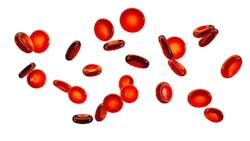Once upon a time, the only treatment for patients with sickle cell disease (SCD) was transfusion… chronic transfusion. As treatments go, chronic transfusion is a less-than-ideal therapy.
Transfusion doesn’t fix the underlying genetic abnormality that causes the red blood cells (RBCs) of some individuals to curve or “sickle,” clogging blood vessels and causing painful crises. But it may help in preventing strokes and organ damage that are often a comorbidity of SCD.
Transfusion can only dilute sickled RBCs and add capacity to carry oxygen throughout the body. Along with being a limited therapy — eventually RBCs from transfusion die — transfusion carries significant risks for individuals with SCD. Of course, every transfusion carries potential risks, but chronic transfusion can lead to alloimmunization, which eventually may make it difficult to find well-matched blood for some patients.
Patients with sickle cell anemia are screened with transcranial doppler (TCD) starting as young as 2 years of age. Those with abnormal transcranial doppler studies are typically started on monthly transfusion. Transfusion is also still an important treatment for patients who develop other complications, like acute chest syndrome, or before surgery to avoid post operative complications.
In the last decade, several treatments have come online as preventatives, starting with hydroxyurea. This drug has been indicated for the treatment of SCD in adults since the late 1990s.
In 2017, the drug was approved as a treatment to reduce the frequency of painful crises and the need for blood transfusions in patients 2 years of age and older with sickle cell anemia with recurrent moderate to severe painful crises.
Hydroxyurea works by increasing the synthesis of fetal hemoglobin (HbF), which inhibits the polymerization of sickle cell hemoglobin (HbS), which causes RBCs to sickle.
In 2017, the US Food and Drug Administration approved L-glutamine oral powder to reduce the acute complications of sickle cell disease in adult and pediatric patients aged 5 years and older. In the pivotal study, patients receiving L-glutamine had fewer pain crises than those receiving placebo. In addition, L-glutamine treatment resulted in fewer hospitalizations due to sickle cell pain and fewer cumulative hospital days. L-glutamine can be used with or without Hydroxyurea.
Crizanlizumab (Adakveo) was approved in 2019 to reduce the frequency of vaso-occlusive crises (pain crises) in adults and pediatric patients with SCD aged 16 years and older. The drug is given as a monthly infusion. Crizanlizumab works by making RBCs less sticky, reducing vaso-occlusion, and thereby decreasing pain crises.
In the SUSTAIN clinical trial, 5 mg crizanlizumab-tmca resulted in fewer pain crises per year compared with placebo. The time to first pain crisis was also extended with use of the drug. This reduction was unrelated to SCD genotype or hyrdroxyurea use. Crizanlizumab is now being investigated as a treatment for younger patients.
Also in 2019, the FDA approved voxelotor (Oxbryta) for the treatment of SCD in adults and pediatric patients aged 12 years and older; the indication has been extended to patients aged 4 years and older.
Voxelotor works by inhibiting polymerization of hemoglobin S into the long chains that cause RBCs to deform. In the pivotal phase III study, more patients receiving voxelotor had a hemoglobin increase of more than 1.0 g/dL from baseline at week 24 — 51% vs. 7% with placebo.
This was regardless of anemia severity at baseline or use of hydroxyurea. Markers of hemolysis were reduced with voxelotor vs. placebo. The annualized incidence of pain crises was slightly lower with 1,500 mg voxelotor than with placebo — 2.77 vs 3.19. However, the drug’s effect on stroke risk and organ damage, among other complications of SCD remains unknown.
None of these drugs are curative, and none work 100% for any patient. However, the effectiveness of combining SCD drugs has yet to be studied systematically. There remains much work to determine which drug works best for which patients and how best to combine drugs.
With several available drugs now, treating SCD complications may become more like treating cancer with multidrug therapy — increasing hemoglobin with voxelotor and reducing pain with crizanlizumab, for example.
So far, there is no defined algorithm for which drugs to use in which order or in which combinations. Mensah said that for patients treated with transfusion or those with organ problems, she tends to recommend treatment with veloxetor.
Gene therapy has become a potential curative treatment for patients with hemoglobinopathies, including SCD, in the past few years. A number of trials are ongoing, and preliminary results for SCD are promising. At the time of writing this article, the FDA approved Zynteglo (betibeglogene autotemcel) — the first cell-based gene therapy for the treatment of adult and pediatric patients with beta-thalassemia (a disorder related to SCD) who require regular red blood cell transfusions.
Bone marrow transplant (BMT) remains an important treatment option for SCD, with the potential to cure the disease. It’s not available or optimal for all patients though.
BMT is also limited by human leukocyte antigen (HLA) matching with the best results coming from related donors, like full brothers or sisters. It’s estimated that only 20% to 30% of candidates have an exact match.
Work is ongoing to improve success with unmatched related donors, matched unrelated donors, and unmatched unrelated donors to expand the number of patients who can be cured with BMT.

